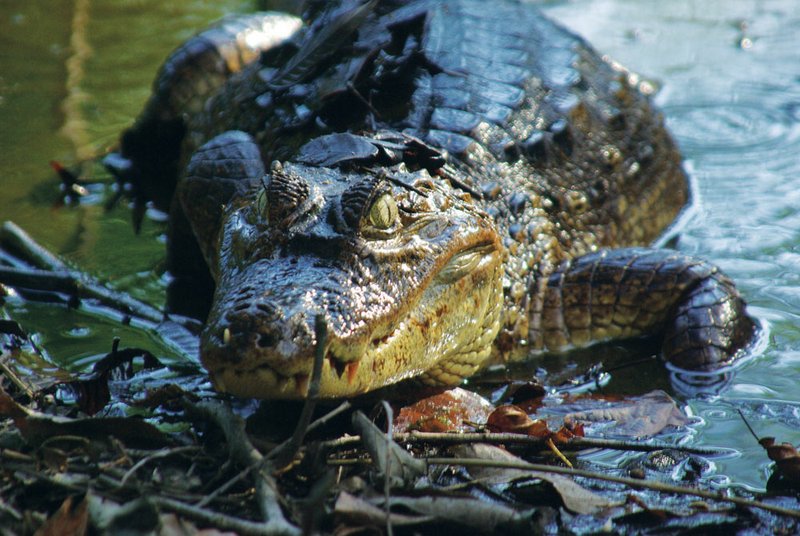March 6 dawned bright and clear in Central America, a perfect fishing day. Seated comfortably on the stern of the Croc-A-Bye Baby, a 35-foot offshore fishing boat, O’Neill Williams and I watched brightly colored teasers skip across the water as we trolled for sailfish off the coast of Costa Rica’s Osa Peninsula. The beautifully clear water of the Pacific gleamed like sapphires.
Friends Jeff Samsel of Clarksville, Ga., and Larry Bozka of Houston, Texas, were chatting behind us. Capt. Geovanni controlled the boat from the tower, while first mate Dainer rigged fresh baits.
“Smart anglers stay focused on the teasers,” said O’Neill, a Georgia native who fishes here often. “When a sailfish rises, you must react quickly, or you’ll miss it.”
I tried to heed O’Neill’s advice, but distractions abounded. I was gazing at the teasers when Dainer shouted, “Look! Manta rays!”
Off the bow, an enormous winged fish flew through the air like a barn door blown by a tornado. Another manta launched behind it, sailing 30 feet before splashing down.
Again, I sat and focused on the teasers. And again, Dainer called.
“Turtles!” he shouted.
We passed near an amorous pair of sea turtles the size of truck tires.
Soon, another shout: “Whale!”
We rushed to the bow and watched as a humpback the size of a U-boat breached 50 yards away. The whale was graceful and magnificent, an incredible sight.
We returned to our places, and this time, my concentration was uninterrupted. Then I saw it — a flash of purple beneath the surface. The swashbuckler raised her sword.
Dainer reeled in the teasers while O’Neill quickly released a rigged baitfish. And in less than the time it takes to tell, the sailfish struck, O’Neill set the hook, and he graciously thrust the rod into my hands.
“She’s yours,” O’Neill said, smiling.
No fish had ever given me such pleasure. Like a ballerina, the beautiful creature twirled on a cobalt-blue dance floor, performing pirouettes and glissades across the water. Again and again, she jumped.
At one point, the sailfish was so far away, I feared I might succumb to her power. But mercifully, she raced toward the boat, allowing me to gain line. When next she jumped, 50 feet off the stern, I could see the ebony spots on her beautiful azure sail.
Finally, I brought the sailfish close. Dainer grabbed the leader. And all too quickly, the encounter ended. Dainer freed the hook from the fish’s jaw, and Jeff and Larry snapped photos before I released the splendid creature. She swam powerfully away.
It was our second day at Crocodile Bay Resort, a renowned fishing and ecotourism lodge in Puerto Jimenez on the Osa Peninsula. The resort sits on the Golfo Dulce (Sweet Gulf) on the east side of the thumb-shaped peninsula, 30 miles west of Panama and 200 miles south of San Jose. The Pacific forms the Osa’s southern and western coasts.
Superlatives are often used when describing the peninsula. National Geographic famously portrayed the Osa as “the most biologically intense place on Earth.” The ticos who live here claim it is the most picturesque, pristine, perfect spot in Costa Rica. Certainly, it is the most remote, which goes a long way toward explaining why the other adjectives apply.
The peninsula shelters the Golfo Dulce from the Pacific, attracting an incredible variety of fish, whales, dolphins, turtles and other sea life. Among the abundant sportfish are inshore species such as roosterfish, snook, barracudas, bonitos, pompanos, snappers and jacks, and offshore powerhouses such as marlins, sailfish, dorados, tunas, goliath groupers and sharks.
It is common to raise more than 20 billfish daily, including sailfish exceeding 100 pounds and marlins tipping the scales at 200-plus. Most dorados top 30 pounds, with tuna always plentiful, including occasional 300-pounders. Many consider Crocodile Bay the world’s No. 1 roosterfish destination, with 25- to 50-pounders caught daily, and the resort record is a whopping 106 pounds.
On our first day at Crocodile Bay, Geovanni and Dainer guided us to a volcanic-reef bonanza of astoundingly colored “pumpkins,” or cubera snappers, plus some bonus jack crevalles. Like most, however, we wanted to catch billfish, and I was elated after landing the 100-pound sail.
On day 3, we explored the Osa’s rain forest with Dennis Valverde, a likable young naturalist familiar with all the region’s plants and animals. Departing at dawn, we traveled a primitive road 10 miles through the jungle, stopping often to photograph an incredible variety of wildlife. Pairs of scarlet macaws seemed to be everywhere, plus unfamiliar birds such as bananaquits, antbirds, jacanas, tityras, colorful tanagers and a rare brown jay. In the trees, we photographed spider monkeys, squirrel monkeys and incredibly loud howlers. We saw a basilisk, or Jesus Christ lizard, run across a creek’s surface on its hind legs.
More treats were in store for us as we walked the extensive resort grounds that afternoon. An 8-foot caiman crawled right up on the bank beside us at a jungle lagoon where, on the opposite bank, a 10-foot American crocodile, the resort’s namesake, was sunning. We saw iguanas, chachalacas, parakeets, tiger-herons and, to cap the trip, the bird we’ve all most hoped to see — a beautiful chestnut-mandibled toucan. In all, we tallied 80 bird species, 48 of which I had never seen.
From start to finish, our Osa adventure was unforgettable. My next visit to Crocodile Bay cannot come soon enough.
